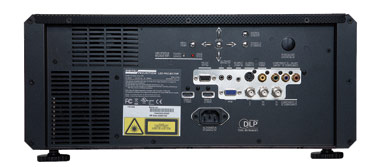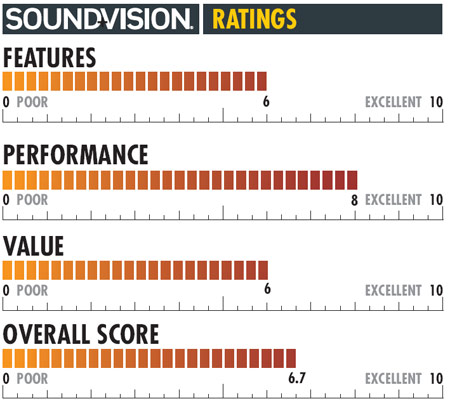Digital Projection M-Vision Cine LED Projector Page 2

PERFORMANCE
After years of hearing hype about LED projection, I was a little disappointed at first to see that the Cine LED’s picture didn’t look terribly different from what I’m used to getting with projectors that use UHP lamps. Then it dawned on me that I was witnessing a minor miracle: a new video-display technology that looked really good from its inception. LCD, plasma, DLP, and LCoS displays all looked mediocre when they were first introduced. It took years before their performance approached that of existing technologies. On a smaller screen, at least, it seems the performance of LEDbased projection is already competitive with regular lamp-based projection.
In fact, in certain ways the LED-driven picture actually looked better than what I’m used to seeing. With Dynamic Black deactivated, its contrast looks just okay (contrast ratio measured 1,801:1 after calibration), but Dynamic Black makes it at least competitive with (and perhaps better than) any DLP projector I’ve seen. With Dynamic Black set to Max, the contrast ratio improves to 5,443:1 and the picture starts to look really good.
The heightened contrast brought out subtleties that made the Blu-ray Disc of 2009’s Star Trek look even more awesome than usual. From the gleaming white spaceships orbiting spectacular celestial bodies to the razor-stubble face of Kirk (Chris Pine), I was consistently impressed by the depth and detail the Cine LED delivered. The only artifact I noticed with Dynamic Black engaged was that when the image fades out, it sometimes seems to drop suddenly from dark gray to deep black. This can be unnerving, but it doesn’t happen often. (And it is impressive once you see how black the screen can get when Dynamic Black dims the LEDs down to their minimum 20% brightness.)
Depending on the picture content, the Cine LED’s Adaptive Contrast feature will both kick up the white level and bring down the black level a little. I found it helpful when watching drab, poorly transferred material streamed from Netflix — which wasn’t surprising given that the projector’s measured contrast ratio jumped to a staggering 58,380:1 with Dynamic Black also activated and set to Max. But well-produced material ended up looking like the movie 300, with exaggerated contrast and an unreal aesthetic.
With the Cine LED’s color-space and color-gamut controls set to Auto, its color rendition looked great, but not significantly different from what I’m used to seeing from UHP-based projectors. Just to see what LED could do, I got into the Cine LED’s hue, saturation, and gain controls for the primary and secondary colors and created a cartoonish, supersaturated color palette that looked absolutely ridiculous on regular program material. But maybe, just maybe, they’ll someday make cameras, production equipment, and video source devices that can exploit LED’s expanded gamut.

BOTTOM LINE
A projector manufacturer recently confided to me that he expects all home theater projectors to use LEDs instead of UHP lamps within 5 years. Based on what I saw with Digital projection’s M-Vision Cine LED DLP, I totally agree. I wish it were brighter — but that’ll happen. I wish it were cheaper — but that’ll happen. Meanwhile, this first-generation projector performs beautifully, and it should keep on performing beautifully day in and day out for many years to come.













































